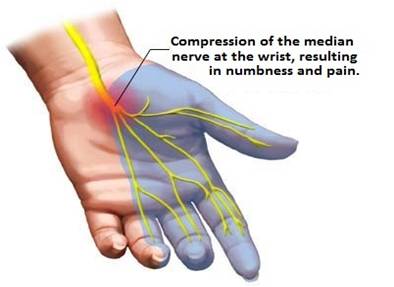Carpal Tunnel Syndrome
Carpal Tunnel Syndrome

What is carpal tunnel syndrome?
Of the many occupational hazards of a teaching career, Carpal Tunnel Syndrome is one. Carpal tunnel syndrome is pain, tingling and other problems in your hand caused by pressure on the median nerve in your wrist.
The median nerve and several tendons run from your forearm to your hand, through a small space in your wrist called the carpal tunnel. The median nerve controls movement and feeling in your thumb and first three fingers, but not your little finger.
What causes carpal tunnel syndrome?
Pressure on the median nerve causes carpal tunnel syndrome. This pressure can come from swelling or anything that makes the carpal tunnel smaller. Things that can lead to carpal tunnel syndrome include:
-
Illnesses such as hypothyroidism, rheumatoid arthritis, and diabetes
-
Pregnancy
-
Obesity
-
Making the same hand movements over and over, especially if the wrist is bent down (your hands lower than your wrists), or making the same wrist movements over and over (like in the case of teachers, data entry professionals etc.)
-
Wrist injuries and bone spurs
-
Smoking, because it can reduce blood flow to the median nerve
What are the symptoms?
Carpal tunnel syndrome can cause tingling, numbness, weakness or pain in the fingers or hand. Some people may have pain in their arm between their hand and their elbow.
Symptoms most often occur in the thumb, index finger, middle finger, and half of the ring finger. If you have problems with your other fingers but your little finger is fine, this may be a sign that you have carpal tunnel syndrome.
How is it treated?
Mild symptoms usually can be treated with home care. The sooner you start treatment, the better are your chances of stopping symptoms and preventing long-term damage to the nerve.
You can do a few things at home to help your hand and wrist feel better, such as:
- Stop activities that cause numbness and pain. Rest your wrist longer between activities.
- Ice your wrist for 10 to 15 minutes once or twice an hour. Try taking non-steroidal anti-inflammatory drugs (NSAIDs) to relieve pain and reduce swelling.
- Wear a wrist splint at night to keep your wrist in a neutral position. This takes pressure off your median nerve. Your wrist is in a neutral position when it is straight or only slightly bent. Holding a glass of water is an example of your wrist in a neutral position.





















